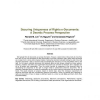Free Online Productivity Tools
i2Speak
i2Symbol
i2OCR
iTex2Img
iWeb2Print
iWeb2Shot
i2Type
iPdf2Split
iPdf2Merge
i2Bopomofo
i2Arabic
i2Style
i2Image
i2PDF
iLatex2Rtf
Sci2ools
114
click to vote
JTAER
2008
2008
Securing Uniqueness of Rights e-Documents: A Deontic Process Perspective
We typically think of documents as carrying information. However, certain kinds of documents do more than that: they are not only informative but also performative in that they represent rights. When these documents are in paper form or some other physical medium, holding the document indicates holding the right. Since the document represents a right, a hazard is that by duplicating the document, one may fraudulently claim a new right. For this reason, physical documents that represent rights are both tamper resistant and copy resistant. However, problems arise when such performative documents are converted to electronic form: duplicates are bit for bit perfect and undetectable. Thus, the normal heuristic of uniqueness of the document token as representing the uniqueness of the right no longer holds for performative electronic documents. This is especially challenging when the rights are transferable, as with various financial instruments such as stocks and bonds. This paper presents ...
| Added | 13 Dec 2010 |
| Updated | 13 Dec 2010 |
| Type | Journal |
| Year | 2008 |
| Where | JTAER |
| Authors | Ronald M. Lee, Vu Nguyen, Anastasia Pagnoni |
Comments (0)

